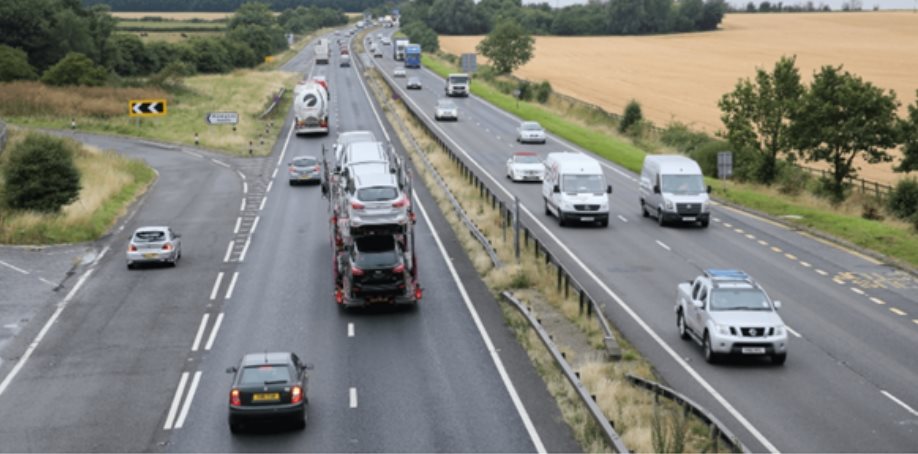

When Atkins India became a part of the A14’s road history altering project
Being one of United Kingdom’s cardinal routes, the A14 Cambridge to Huntingdon (A14 C2H) improvement scheme included a major new bypass to the south of Huntingdon - a 21 mile road augmentation program. The construction work on the project, which was officially started in November 2016, is complete and the route is now fully operational, eight months prior to the scheduled completion timeline.
Image Courtesy: Highways England
The ambitious projectMaking history as the biggest road projects in the UK, the A14 Cambridge to Huntingdon improvement scheme now makes an indispensable route for nearly 85,000 drivers transporting essentials in and around the UK. One of the most challenging projects that has been undertaken by Atkins, the A14 made a milestone achievement, by delivering the project eight months earlier than its scheduled time, even in the wake of the Covid-19 pandemic.
Its significanceThe intent behind the inception of A14 Cambridge to Huntingdon (A14 C2H) improvement scheme was to cut down the travel time, thereby increasing the reliability, easing the traffic congestion, and eventually enhancing the commercial growth of the local community. The detailed design of A14 was assigned to Atkins and CH2MHill joint venture as part of the Collaborative Delivery Frame-work (CDF).
Atkins’ role in this projectAtkins, as a part of the Integrated Design Team commissioned by the Highways England, led to the preparation of the full business case for the £1.5bn scheme to upgrade the A14 between Cambridge and Huntingdon on behalf of Highways England. Atkins’ Global Design Centre (GDC), in India was assigned to deliver the detailed design of Sections 3B, 4A and 5. The project’s scope included the validation of the preliminary design, design and deliverables for the contractor’s pricing as well as for the construction. Approximately 80 resources from various disciplines in the GDC such as Highways, Structures, Drainage, Geotech, Lighting, GIS and Landscape worked on this prestigious project for 18 months. Our multi-discipline team, comprising of Murali Balla - GDC PM, Anil Veernapu - Highways Lead, Debabrata Mukherjee – Bridges, Anindya Chattopadhyay, Amita Mantri, Smita Sawdadkar – Drainage, PMO - Shaik Karimulla, Monika Nair – Landscape and Abhishek Jain – Geotech, worked collaboratively to deliver the designs.
Once the designs were completed, the team from our UK offices were thereafter stationed at site for supporting the contractor’s site team, The construction work on the project required the employment of over 14,000 people in total, who worked for almost 14 million hours to deliver an early opening for the traffic on the new A14 route.
Key highlights of the project- The procurement of raw materials, particularly the earth, was done from the nearby areas, that eventually reduced the number of trips to transport them from far off places.
- The road closure period for the project was reduced to a minimum by undertaking a majority of work, off the roads.
- Ensured that renewable electricity and non -potable water is used, until the delivery of the project
- So that the ecosystem is rendered to its previous state, the project team planted more than 900,000 trees and shrubs.
Under the Archaeological inquiry which is an integral part of major infrastructural projects in the UK, some major findings were unearthed during 40 separate excavations by a team of 250 archaeologists. The project was given the “Rescue Project of the Year” award in the 2019 Current Archaeology Awards.
The successful completion of this project not only creates an economic significance but also reflects the positive impact of making anything possible through collaboration, even if it is during an unprecedented lockdown.
Interested? Find out more about life at AtkinsRéalis
Sign up to receive the latest content tailored to your interests
Our articles

Preview
EuropeContent type
BlogsPublish date
03/12/2025
Summary
Hi, I'm Lana. I hold a French engineering degree in geotechnical and civil engineering from Polytech Grenoble, which included a two-semester Erasmus+ exchange at Loughborough University. My journ

Preview
IndiaContent type
BlogsPublish date
03/07/2025
Summary
Hello, my name is Manali, and I work at AtkinsRéalis at the Global Technology Centre (GTC) in India. This International Women's Day, I want to tell you about my career journey, which has been as

by
Akash Kumar
.jpg)
Preview
EuropeContent type
BlogsPublish date
03/06/2025
Summary
The state of the UK water industry Water is the foundation of life. It sustains communities, powers industries, and supports ecosystems—but across the world, this critical resource is under increa
.jpg)
Preview
GeneralContent type
BlogsPublish date
03/06/2025
Summary
What are social value jobs? Social value jobs aren’t just roles with ‘social value’ in the title—they’re careers that make a tangible impact on communities, the environment, and society as a whole
.png)
Preview
IndiaContent type
BlogsPublish date
03/05/2025
Summary
Hi, my name is Britty. I'm a Chartered Water and Environmental Manager based in Bengaluru. I have over seven years of engineering experience in the water and wastewater industry and work in the Gl

by
Akash Kumar

Preview
Middle EastContent type
BlogsPublish date
03/03/2025
Summary
The importance of job satisfaction can’t be understated. When we work in a great place, we do our job with a smile. At AtkinsRéalis, we’re committed to being the best place in the Middle East for impa

Preview
Middle EastContent type
BlogsPublish date
03/03/2025
Summary
Civil engineering jobs in the Middle East are among the most in demand and exciting opportunities in the industry. Backed by ambitious sustainability goals and mega-projects like NEOM, the growth

Preview
CanadaContent type
BlogsPublish date
03/03/2025
Summary
Snippet title Lire en français Mechanical engineering jobs in Canada are in higher demand than ever. With technological advancements and a growing emphasis on sustainability in the industry

Preview
IndiaContent type
BlogsPublish date
03/03/2025
Summary
Being a woman is still seen as a disqualification for many professions, even today, especially in male-dominated fields like civil and mechanical engineering. Motherhood adds another layer of re

by
Akash Kumar

Preview
EuropeContent type
BlogsPublish date
02/25/2025
Summary
Hello, I'm Justin. As Associate Director of Project and Programme Services at AtkinsRéalis, I work on complex projects in the highways and infrastructure sectors whilst also leading a team of peo

Preview
AsiaContent type
BlogsPublish date
02/12/2025
Summary
Snippet title Lire en français Engineering has traditionally been a male-dominated field, but this dynamic is steadily changing. Women are breaking barriers and excelling in STEM careers

Preview
CanadaContent type
BlogsPublish date
02/11/2025
Summary
Snippet title Lire en français Meet Benisa, a resilient and dedicated professional at AtkinsRéalis. Her career journey showcases growth and the impact of an inclusive work culture. Overcom
Related jobs
We are sorry but we currently have no jobs in this area.
Continue browsing to look at our other available opportunities
We are sorry but we currently have no jobs in this area.
Continue browsing to look at our other available opportunities
We are sorry but we currently have no jobs in this area.
Continue browsing to look at our other available opportunities

Equality, diversity and inclusion
We’re devoted to growing the diversity of our people, promoting an inclusive culture, providing everyone with an equal voice because simply put, it’s the right thing to do. Click to learn more.
Find out more




